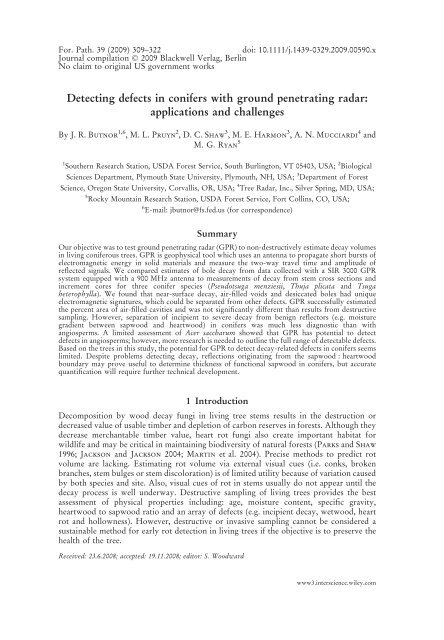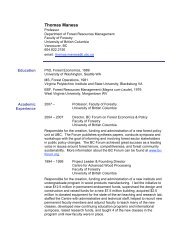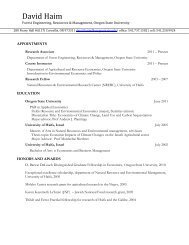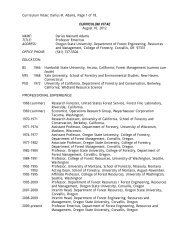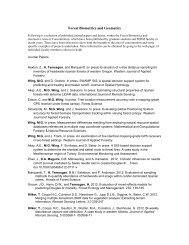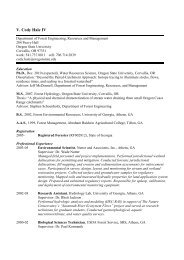Detecting defects in conifers with ground penetrating radar - Forest ...
Detecting defects in conifers with ground penetrating radar - Forest ...
Detecting defects in conifers with ground penetrating radar - Forest ...
You also want an ePaper? Increase the reach of your titles
YUMPU automatically turns print PDFs into web optimized ePapers that Google loves.
For. Path. 39 (2009) 309–322doi: 10.1111/j.1439-0329.2009.00590.xJournal compilation Ó 2009 Blackwell Verlag, Berl<strong>in</strong>No claim to orig<strong>in</strong>al US government works<strong>Detect<strong>in</strong>g</strong> <strong>defects</strong> <strong>in</strong> <strong>conifers</strong> <strong>with</strong> <strong>ground</strong> penetrat<strong>in</strong>g <strong>radar</strong>:applications and challengesBy J. R. Butnor 1,6 , M. L. Pruyn 2 , D. C. Shaw 3 , M. E. Harmon 3 , A. N. Mucciardi 4 andM. G. Ryan 51 Southern Research Station, USDA <strong>Forest</strong> Service, South Burl<strong>in</strong>gton, VT 05403, USA; 2 BiologicalSciences Department, Plymouth State University, Plymouth, NH, USA; 3 Department of <strong>Forest</strong>Science, Oregon State University, Corvallis, OR, USA; 4 Tree Radar, Inc., Silver Spr<strong>in</strong>g, MD, USA;5 Rocky Mounta<strong>in</strong> Research Station, USDA <strong>Forest</strong> Service, Fort Coll<strong>in</strong>s, CO, USA;6 E-mail: jbutnor@fs.fed.us (for correspondence)SummaryOur objective was to test <strong>ground</strong> penetrat<strong>in</strong>g <strong>radar</strong> (GPR) to non-destructively estimate decay volumes<strong>in</strong> liv<strong>in</strong>g coniferous trees. GPR is geophysical tool which uses an antenna to propagate short bursts ofelectromagnetic energy <strong>in</strong> solid materials and measure the two-way travel time and amplitude ofreflected signals. We compared estimates of bole decay from data collected <strong>with</strong> a SIR 3000 GPRsystem equipped <strong>with</strong> a 900 MHz antenna to measurements of decay from stem cross sections and<strong>in</strong>crement cores for three conifer species (Pseudotsuga menziesii, Thuja plicata and Tsugaheterophylla). We found that near-surface decay, air-filled voids and desiccated boles had uniqueelectromagnetic signatures, which could be separated from other <strong>defects</strong>. GPR successfully estimatedthe percent area of air-filled cavities and was not significantly different than results from destructivesampl<strong>in</strong>g. However, separation of <strong>in</strong>cipient to severe decay from benign reflectors (e.g. moisturegradient between sapwood and heartwood) <strong>in</strong> <strong>conifers</strong> was much less diagnostic than <strong>with</strong>angiosperms. A limited assessment of Acer saccharum showed that GPR has potential to detect<strong>defects</strong> <strong>in</strong> angiosperms; however, more research is needed to outl<strong>in</strong>e the full range of detectable <strong>defects</strong>.Based on the trees <strong>in</strong> this study, the potential for GPR to detect decay-related <strong>defects</strong> <strong>in</strong> <strong>conifers</strong> seemslimited. Despite problems detect<strong>in</strong>g decay, reflections orig<strong>in</strong>at<strong>in</strong>g from the sapwood : heartwoodboundary may prove useful to determ<strong>in</strong>e thickness of functional sapwood <strong>in</strong> <strong>conifers</strong>, but accuratequantification will require further technical development.1 IntroductionDecomposition by wood decay fungi <strong>in</strong> liv<strong>in</strong>g tree stems results <strong>in</strong> the destruction ordecreased value of usable timber and depletion of carbon reserves <strong>in</strong> forests. Although theydecrease merchantable timber value, heart rot fungi also create important habitat forwildlife and may be critical <strong>in</strong> ma<strong>in</strong>ta<strong>in</strong><strong>in</strong>g biodiversity of natural forests (Parks and Shaw1996; Jackson and Jackson 2004; Mart<strong>in</strong> et al. 2004). Precise methods to predict rotvolume are lack<strong>in</strong>g. Estimat<strong>in</strong>g rot volume via external visual cues (i.e. conks, brokenbranches, stem bulges or stem discoloration) is of limited utility because of variation causedby both species and site. Also, visual cues of rot <strong>in</strong> stems usually do not appear until thedecay process is well underway. Destructive sampl<strong>in</strong>g of liv<strong>in</strong>g trees provides the bestassessment of physical properties <strong>in</strong>clud<strong>in</strong>g: age, moisture content, specific gravity,heartwood to sapwood ratio and an array of <strong>defects</strong> (e.g. <strong>in</strong>cipient decay, wetwood, heartrot and hollowness). However, destructive or <strong>in</strong>vasive sampl<strong>in</strong>g cannot be considered asusta<strong>in</strong>able method for early rot detection <strong>in</strong> liv<strong>in</strong>g trees if the objective is to preserve thehealth of the tree.Received: 23.6.2008; accepted: 19.11.2008; editor: S. Woodwardwww3.<strong>in</strong>terscience.wiley.com
310 J. R. Butnor, M. L. Pruyn, D. C. Shaw et al.The prior state of the art for identify<strong>in</strong>g decay <strong>in</strong> liv<strong>in</strong>g trees <strong>with</strong> field portableequipment (not <strong>in</strong>clud<strong>in</strong>g X-ray, computed tomography (CAT) scan and nuclear magneticresonance imag<strong>in</strong>g (NMR) can be categorized as utiliz<strong>in</strong>g: (i) electrical sensors (Tattarand Shigo 1972; Shortle and Smith 1987; Larsson et al. 2004), (ii) penetrometers, e.g.ResistographÔ, IML GmbH, Wiesloch, Germany (Bethge et al. 1996; Costello andQuarles 1999), (iii) ultrasonic sensors, e.g. Arborsonic Decay Detector Fujikura EuropeLtd. Wiltshire, UK (Xu et al. 2000; Le<strong>in</strong><strong>in</strong>ger et al. 2001) and the Picus Sonic Tomograph,Argus Electronics GmbH, Rostock, Germany (Gilbert and Smiley 2004) or (iv) <strong>ground</strong>penetrat<strong>in</strong>g <strong>radar</strong> (GPR) (Miller and Doolittle 1990; Pérez-Gracia et al. 2002;Nicolotti et al. 2003), e.g. Tree Radar Unit, TreeRadar Inc., Silver Spr<strong>in</strong>g, MD, USA.Among these methods, only GPR can be considered truly non-<strong>in</strong>vasive, for the othersrequire the <strong>in</strong>sertion of a drill bit or probe to make an assessment. GPR is also able tocollect cont<strong>in</strong>uous data around the circumference of a tree.As wood <strong>in</strong> liv<strong>in</strong>g trees has variable electromagnetic properties (i.e. dielectricpermittivity), it should be a good subject for GPR. By exploit<strong>in</strong>g the electromagneticcontrast between tree roots and soil, scientists have applied GPR to map coarse rootsystems of trees (Hruska et al. 1999) and survey root system biomass over a broad range ofsoil conditions (Butnor et al. 2001, 2003; Stover et al. 2007). Impulse propagation <strong>with</strong><strong>in</strong>wood depends on the dielectric properties of bound water, free water and cell wallcomponents (Nicolotti et al. 2003). Therefore, the total porosity and the total watersaturation and sal<strong>in</strong>ity affect the radio wave propagation. Decay<strong>in</strong>g wood is expected tohave a different moisture content and density from sound wood and thus should also have acharacteristic dielectric constant (Nicolotti et al. 2003). Miller and Doolittle (1990)used GPR to locate knots and areas of <strong>in</strong>cipient and brown rot <strong>in</strong> four different angiospermtree species. The accuracy of the defect locations was confirmed when the trees were laterfelled and cut <strong>in</strong>to boards. Nicolotti et al. (2003) found that high dielectric values werewell correlated <strong>with</strong> the <strong>in</strong>ner decayed core of two Platanus hybrida Brot. Although thesestudies endorsed the use of the GPR for detect<strong>in</strong>g the presence and extent of rot <strong>in</strong>angiosperms, both <strong>in</strong>dicated the need for more extensive <strong>radar</strong> studies to further evaluateGPRÕs applicability to other species, such as gymnosperms.There are two ma<strong>in</strong> issues that may limit the utility of us<strong>in</strong>g GPR to quantify wooddecay. The first is whether there is sufficient electromagnetic contrast to dist<strong>in</strong>guishdecayed from non-decayed wood. The second is whether benign conditions such as normalmoisture and density gradients, res<strong>in</strong> pockets, and heartwood formation will produce<strong>in</strong>terference that prevents the del<strong>in</strong>eation of <strong>defects</strong>. While GPR methodology has beenavailable for some time, there are few published accounts evaluat<strong>in</strong>g its ability to detect<strong>defects</strong> <strong>in</strong> stand<strong>in</strong>g trees (Miller and Doolittle 1990; Pérez-Gracia et al. 2002;Nicolotti et al. 2003). In addition, these <strong>in</strong>itial studies were strictly qualitative andobservational and did not present quantitative data l<strong>in</strong>k<strong>in</strong>g GPR <strong>radar</strong>grams to <strong>defects</strong> <strong>in</strong>liv<strong>in</strong>g trees.Our objective was to test and apply GPR to non-destructively estimate decay volumes<strong>in</strong> liv<strong>in</strong>g coniferous trees. We selected three long-lived conifer species common <strong>in</strong> thePacific Northwest: Douglas fir (Pseudotsuga menziesii Mirb. Franco), Western hemlock(Tsuga heterophylla Raf. Sarg.) and Western redcedar (Thuja plicata Don ex D. Don).Specifically, we sought to: (i) identify which decay-related <strong>defects</strong> were detectable, (ii)determ<strong>in</strong>e if GPR used <strong>in</strong> reflection mode could accurately def<strong>in</strong>e the marg<strong>in</strong>s of decay,(iii) identify issues that need to be considered (i.e. equipment, sampl<strong>in</strong>g protocol and postcollectionprocess<strong>in</strong>g) to implement GPR for heart rot surveys <strong>in</strong> these conifer species. Thestudy <strong>in</strong>volved an <strong>in</strong>itial phase of scann<strong>in</strong>g coupled <strong>with</strong> an <strong>in</strong>tensive destructiveverification followed by work at a research facility where destructive sampl<strong>in</strong>g wasundesirable and quantification of decay would augment other studies related to carbonstorage and cycl<strong>in</strong>g.
<strong>Detect<strong>in</strong>g</strong> <strong>defects</strong> <strong>in</strong> <strong>conifers</strong> <strong>with</strong> GPR2 Materials and methodsThe <strong>in</strong>itial strategy for test<strong>in</strong>g GPR to study wood decay on large <strong>conifers</strong> was two-fold: (i)Scan the base of trees <strong>with</strong> a variety of <strong>defects</strong>, fell them, scan multiple elevations of thetrunk while on the <strong>ground</strong> and dissect cross-sections which corresponded <strong>with</strong> thecollected <strong>radar</strong>grams, (ii) Scan multiple elevations on stand<strong>in</strong>g trees at the W<strong>in</strong>d RiverCanopy Crane site near Carson, WA us<strong>in</strong>g expert tree climbers and collect periodic<strong>in</strong>crement cores to verify <strong>radar</strong>grams.3112.1 Study areasWork<strong>in</strong>g closely <strong>with</strong> employees of Gifford P<strong>in</strong>chot National <strong>Forest</strong> <strong>in</strong> March 2005, 10large <strong>conifers</strong> identified as Ôhazard treesÕ and scheduled for removal were located. Trees hadone or more symptoms of disease (i.e. th<strong>in</strong>n<strong>in</strong>g crown, branch shedd<strong>in</strong>g, chlorosis) as wellas physical damage from fire or basal <strong>in</strong>jury. The trees were located <strong>in</strong> the North ForkCamp<strong>ground</strong> [Cowlitz Valley Ranger District (CVRD), 46°42¢N, 121°84¢W, 775 melevation] near Randle, WA and <strong>in</strong> the W<strong>in</strong>d River Experimental <strong>Forest</strong> (WREF) along<strong>Forest</strong> Service road 43 near Stabler, WA (Mt. Adams Ranger District near 45°49¢13.76¢N,121°57¢06.88¢W, 350 m elevation). At North Fork, three P. menziesii aged approximately200 years, 40–68 m height, one T. heterophylla, 36 m height, one T. plicata, 21 m heightand one P. menziesii dead snag were selected. The trees selected at the WREF <strong>in</strong>cluded: oneP. menziesii, approximately 43 m height and three T. heterophylla, 34–43 m height.Trees for the second phase of the study were located at the W<strong>in</strong>d River Canopy CraneResearch Facility (WRCCRF, located at 45°49¢13.76¢N, 121°57¢06.88¢W, elevation 368 m).The site is situated <strong>in</strong> a 450-year-old forest <strong>in</strong> the W<strong>in</strong>d River valley of the southernWash<strong>in</strong>gton Cascade Range, approximately 75 km east of Portland, OR, near Carson, WA,USA and is typical of an old-growth forest west of the Cascades (Shaw et al. 2004). Weselected n<strong>in</strong>e trees (three of each species; P. menziesii, T. heterophylla and T. plicata)<strong>with</strong><strong>in</strong> the footpr<strong>in</strong>t of the canopy access crane. One additional tree of each species <strong>with</strong>visible signs or symptoms of bole decay was selected from outside the crane plot.2.2 EquipmentAll <strong>radar</strong>grams were collected <strong>with</strong> a SIR 3000 <strong>ground</strong> penetrat<strong>in</strong>g <strong>radar</strong> unit equipped<strong>with</strong> a 900 MHz center frequency antenna (Model 3101D; GSSI Inc., Salem, NH, USA).While precise resolution size is dependent on dielectric permittivity of the substrate,penetration averages 1 m <strong>in</strong> depth. The antenna is a transducer comprised of a dipoletransmitter and a receiver packaged <strong>in</strong>to one unit <strong>with</strong> dimensions of 8 · 18 · 33 cm, andequipped <strong>with</strong> a handle and a small survey wheel (Fig. 1). Based on tree diameter,collection parameters consisted of: (i) two-way travel time (8–21 ns) for the energy to reachthe center of the tree and be reflected back to the receiver and (ii) ga<strong>in</strong> sett<strong>in</strong>gs whichamplify the reflected signal. To collect data, the antenna was placed aga<strong>in</strong>st the trunk of atree and moved circumferentially to acquire a complete <strong>radar</strong>gram of the selected trunkelevation (Fig. 1). It was important for the antenna to ma<strong>in</strong>ta<strong>in</strong> good contact <strong>with</strong> the bark;large air gaps or operator ÔwobblesÕ degrade the quality of the scan. In situations where acomplete scan of the tree was blocked by a branch stub or a tree was on the <strong>ground</strong> and thefull circumference could not be accessed, a partial scan was collected. The spr<strong>in</strong>g-loadedsurvey wheel, which ma<strong>in</strong>ta<strong>in</strong>s contact <strong>with</strong> the bark surface, was used to meterelectromagnetic pulses, effectively l<strong>in</strong>k<strong>in</strong>g data collection density to distance traveled.Every 5 mm, a reflection trace or waveform comprised of the amplitude of reflected energyand the two-way travel time was collected. These waveforms were stacked to create a<strong>radar</strong>gram, which is essentially a two dimensional profile of reflection data (amplitude and
<strong>Detect<strong>in</strong>g</strong> <strong>defects</strong> <strong>in</strong> <strong>conifers</strong> <strong>with</strong> GPRby 100%. Specific gravity was calculated as the segment dry mass divided by fresh volume.Sub-samples from four P. menziesii (8–10 heights per tree), four T. heterophylla (6–10heights per tree), one T. plicata (8 heights) and one dead snag (2 heights) were processed.We were only permitted to cut one T. plicata which posed an unacceptable risk <strong>in</strong> a publiccamp<strong>ground</strong>.3132.4 GPR scann<strong>in</strong>g and <strong>in</strong>crement borer verificationExpert tree climbers were employed to scan 10–15 elevations per tree, and periodicallycollect cores <strong>with</strong> an <strong>in</strong>crement borer. Work<strong>in</strong>g at these heights (up to 55 m) was difficultand required two climbers and one <strong>ground</strong> attendant to clear ropes. To make ameasurement, one climber would start the scan and hand the antenna off to the otherclimber on the opposite side of the tree to make a complete scan (Fig. 1). The gondola ofthe crane was used to support the climbers by ferry<strong>in</strong>g supplies and hold<strong>in</strong>g the SIR 3000which was connected to the antenna by a 30-m cable. It usually required 4 h to profile as<strong>in</strong>gle tree. Depend<strong>in</strong>g on time constra<strong>in</strong>ts (afternoon w<strong>in</strong>ds frequently <strong>ground</strong>ed thecrane), 3–5 <strong>in</strong>crement cores were collected per tree. The sapwood : heartwood boundary <strong>in</strong>the <strong>in</strong>crement core was identified visually by a change <strong>in</strong> color or moisture <strong>in</strong> the wood andsapwood thickness was recorded. The cores were divided <strong>in</strong>to outer bark, <strong>in</strong>ner barkand wood. The wood was cut <strong>in</strong>to 2.5 cm segments until the pith. Fresh mass, length anddiameter of each segment were recorded. The segments were dried at 50°C for 48 h,and then dry mass was recorded. Core segment volumes were calculated as cyl<strong>in</strong>ders us<strong>in</strong>gthe measured length and diameter dimensions. Moisture content and specific gravity werecalculated as described previously.2.5 Additional sampl<strong>in</strong>g of eastern treesIn previously published studies (e.g. Miller and Doolittle 1990; Pérez-Gracia et al.2002; Nicolotti et al. 2003), GPR had been exclusively used for evaluat<strong>in</strong>g angiospermtree species (hardwood sp.). Given that the early results <strong>with</strong> the three Western <strong>conifers</strong>pecies were less diagnostic than reported for hardwood tree species, we rapidly surveyedadditional younger and smaller trees <strong>in</strong> Charlotte, Vermont (44°16¢N, 73°11¢W 108 melevation) to give context to the Western data. Fifteen vigorous Tsuga canadensis trees aged50–80 (40–60 cm diameter at breast height, DBH) years were scanned at breast height andthe sapwood : heartwood boundary visually verified <strong>with</strong> a core collected <strong>with</strong> an<strong>in</strong>crement borer. Fifteen Acer saccharum trees tree aged 40–100 years (45–60 cm DBH)were scanned at breast height and visually verified <strong>with</strong> an <strong>in</strong>crement borer. Thesapwood : heartwood boundary <strong>in</strong> T. canadensis was identified as the transition from wetto dry wood. In A. saccharum, the transition from creamy white wood to beige or lightbrown wood was determ<strong>in</strong>ed to be the boundary between heartwood and sapwood.2.6 Process<strong>in</strong>g dataAll <strong>radar</strong> data were processed <strong>with</strong> Radan 6.5, a multipurpose, post-collection GPRanalysis software package. The ability of GPR to accurately scale the distance from theoutside of the tree to a specific reflector is dependent on relative dielectric permittivity ofthe stem. In angiosperms, the relative dielectric permittivity (unitless) is quite uniform,averag<strong>in</strong>g 13 (Dr A. Mucciardi, unpublished data). Prelim<strong>in</strong>ary tests <strong>with</strong> the western<strong>conifers</strong> showed that this value seemed robust and was applied as the data were collected.To date, <strong>conifers</strong> have been little studied <strong>with</strong> the GPR and required close comparisonbetween <strong>radar</strong> data and destructive verification. GPR data is commonly visualized as awave <strong>with</strong> positive and negative cycles as would be viewed on an oscilloscope. The most
314 J. R. Butnor, M. L. Pruyn, D. C. Shaw et al.pert<strong>in</strong>ent <strong>in</strong>formation is the two-way travel time to phase changes, which relate to thedepth of an electrical anomaly and the relative amplitude of each cycle. Raw, unfiltereddata is difficult to <strong>in</strong>terpret, because of signal attenuation and amplitude loss as the energymoves through the bole and is reflected back to the bark surface. To compensate for theloss of energy, ga<strong>in</strong> is added dur<strong>in</strong>g the collection process. Post-collection data filter<strong>in</strong>g wasapplied to standardize <strong>in</strong>terpretation, by scal<strong>in</strong>g the amplitude of the entire waveform tothe amplitude of the front surface reflection. The front surface reflection is the firstpositive ⁄ negative cycle and it is usually the strongest reflection. Secondary and tertiaryoscillations <strong>in</strong>dicate cross coupl<strong>in</strong>g between the pulse and receiver dipoles. Once data arescaled, detections caused by reflect<strong>in</strong>g surfaces are identified when the amplitude of areflected signal crosses a user-def<strong>in</strong>ed threshold. This is a relative scale which can bechanged based on whether the desired feature or condition <strong>with</strong><strong>in</strong> a bole is detectable (i.e.can be discrim<strong>in</strong>ated from healthy tree) and was typically 1 ⁄ 3 of the front surfacereflection. To evaluate which features were detectable, physical data collected from treecross-sections or <strong>in</strong>crement cores were directly compared <strong>with</strong> the waveforms. This wasaccomplished by creat<strong>in</strong>g a schematic of the different features (bark, sapwood, heartwoodand defect class) <strong>with</strong> the correspond<strong>in</strong>g waveform diagram.To create two dimensional area projections representative of a ÔsliceÕ of the bole at aspecific elevation, the depth from the outside of the tree to the first peak above thedetection threshold was exported from the l<strong>in</strong>ear <strong>radar</strong>gram. The anomaly was mapped ona polar plot us<strong>in</strong>g the assumption that the outer circumference of the bark was a perfectcircle. From this projection, an estimate of the percent area of the tree compromised by adefect could be obta<strong>in</strong>ed. We compared the <strong>radar</strong> estimate of defected area to the imageanalysis assessment for 78 destructively sampled cross-sectional disks. The total area of alldefect categories (i.e. sta<strong>in</strong>, wet wood, <strong>in</strong>cipient decay, decay and air-filled cavities)estimated by GPR was compared to the area obta<strong>in</strong>ed <strong>with</strong> imagej software fromphotographs.3 Results3.1 <strong>Detect<strong>in</strong>g</strong> normal conditions <strong>with</strong> <strong>radar</strong>Two dist<strong>in</strong>ct responses of the 900 MHz frequency range to normal wood anatomy wereobserved <strong>in</strong> the <strong>conifers</strong> studied <strong>in</strong> this experiment. Waveforms from trees <strong>with</strong> relativelyth<strong>in</strong> bark (
<strong>Detect<strong>in</strong>g</strong> <strong>defects</strong> <strong>in</strong> <strong>conifers</strong> <strong>with</strong> GPR315Fig. 2. Response of the 900 MHz frequency range to normal anatomy of: (a) healthy conifer <strong>with</strong> th<strong>in</strong>bark (15 cm)(P. menziesii, CVRD) and (c) healthy angiosperm (Acer saccharum, VT). The schematic diagram ofanatomic features (above) corresponds to waveform diagrams (below) scaled relative to the frontsurface reflection. The detection threshold is represented by the dashed l<strong>in</strong>e.dependent. The waveform diagrams presented are representative of the <strong>defects</strong> be<strong>in</strong>gcompared, though there is considerable po<strong>in</strong>t to po<strong>in</strong>t variation <strong>in</strong> the specific time andamplitude values for <strong>in</strong>dividual trees. Severe decay or heart rot was not dist<strong>in</strong>guishablefrom normal anatomic structures <strong>in</strong> any of the <strong>conifers</strong> <strong>in</strong> this study. For example, onelarge P. menziesii (107 cm diameter) exhibited severe heart rot encompass<strong>in</strong>g more than35% of the basal area; however this defect was not detected because it did not cross thedetection threshold (Fig. 3a) and could not be discrim<strong>in</strong>ated from <strong>in</strong>tact wood (e.g.Fig. 2b). Incipient or early stage decay was also not consistently detected <strong>in</strong> live <strong>conifers</strong>.Wetwood is a common defect <strong>in</strong> T. heterophylla heartwood, however, any reflectioncaused by wetwood was <strong>in</strong>dist<strong>in</strong>guishable from the peak associated <strong>with</strong> the sapwood: heartwood boundary (Fig. 2). Analysis of cores revealed that heartwood devoid ofany decay had lower moisture content than sapwood, though some T. plicata had layers ofwater soaked heartwood, which caused high amplitude reflections. These reflections wereoften much stronger than those associated <strong>with</strong> decay. M<strong>in</strong>or shake between annual r<strong>in</strong>gswas present <strong>in</strong> a few T. canadensis trees, but was undetectable <strong>with</strong> GPR. None of thesetrees possessed <strong>in</strong>ternal decay.There were numerous <strong>in</strong>stances where destructive <strong>in</strong>terference was noted <strong>in</strong> the firstnegative peak (Fig. 3b) of the waveform diagram. This was caused by deep furrows orvoids <strong>in</strong> the external surface of the bark (Fig. 3b) or air-filled fractures <strong>in</strong> the bark wherebark slough<strong>in</strong>g was tak<strong>in</strong>g place. One tree had unusual sapwood decay just below the barkwhich similarly resulted <strong>in</strong> destructive <strong>in</strong>terference. When destructive <strong>in</strong>terference waspresent <strong>in</strong> the near-surface, detection of features deeper <strong>with</strong><strong>in</strong> the trunk was compromised,analogous to antenna decoupl<strong>in</strong>g from the surface of the tree (not shown).In contrast to the negative results <strong>with</strong> decay; dry, dead wood, where the typicalmoisture gradient from wet sapwood to dry heartwood was less dist<strong>in</strong>ct or absent wasreadily identified <strong>in</strong> <strong>conifers</strong>. The negative peak associated <strong>with</strong> the sapwood : heartwood<strong>in</strong>terface <strong>in</strong> healthy trees (Fig. 2a,b) was absent (Fig. 3c) <strong>in</strong> dry dead wood. TwoT. heterophylla trees possessed large volumes of blue-sta<strong>in</strong> fungus, were desiccated and didnot exhibit a negative peak associated <strong>with</strong> the sapwood : heartwood boundary similar toP. menziesii (Fig. 3c). Hollows (air filled) were readily detected and characterized bymultiple negative peaks which extend beyond the sapwood heartwood <strong>in</strong>terface (Fig. 3d).
316 J. R. Butnor, M. L. Pruyn, D. C. Shaw et al.Fig. 3. Response of the 900 MHz frequency range to a variety of <strong>in</strong>ternal <strong>defects</strong> and decay: (a) severeheart rot (P. menziesii, WREF), (b) air-filled void on the outer surface of the bark (P. menziesii,CVRD), (c) desiccated wood <strong>with</strong> no decay (P. menziesii, WREF), (d) air-filled hollow (Tsugaheterophylla, WREF), and (e) severe decay <strong>in</strong> an angiosperm (A. saccharum, VT). The schematicdiagram of anatomic features (above) corresponds to waveform diagrams (below) scaled relative to thefront surface reflection. The detection threshold is represented by the dashed l<strong>in</strong>e.The absence of any <strong>in</strong>ternal reflections <strong>in</strong> healthy A. saccharum (Fig. 2c) made it possibleto consistently detect moderate to severe decay (Fig. 3e) <strong>with</strong>out <strong>in</strong>terference from normalanatomic features (visually verified <strong>with</strong> <strong>in</strong>crement bor<strong>in</strong>gs). The diagrams of severe tomoderate decay and air-filled hollows were very similar <strong>in</strong> the distribution of peaks, but theamplitude of the reflected energy was marg<strong>in</strong>ally higher <strong>in</strong> the hollow A. saccharum. Itseems unlikely that severe decay can be dist<strong>in</strong>guished from hollow boles. Sta<strong>in</strong><strong>in</strong>g and<strong>in</strong>cipient decay was not detectable <strong>in</strong> A. saccharum.In Fig. 3a–e, considerable variation can be seen <strong>in</strong> the smaller peaks (right side) whichfollow the <strong>in</strong>itial high-amplitude detection peaks (left side). These reflections are essentiallyback<strong>ground</strong> noise and so reveal little diagnostic <strong>in</strong>formation. The variation <strong>in</strong> amplitude <strong>in</strong>these peaks makes them seem different <strong>in</strong> the preced<strong>in</strong>g figures, but it is due to variationamong <strong>in</strong>dividual trees and different data collection and process<strong>in</strong>g sett<strong>in</strong>gs. Small diametertrees are scanned at lower time ranges and different ga<strong>in</strong> sett<strong>in</strong>gs than larger trees tocompensate for signal attenuation based on tree diameter.
<strong>Detect<strong>in</strong>g</strong> <strong>defects</strong> <strong>in</strong> <strong>conifers</strong> <strong>with</strong> GPR3.3 Estimat<strong>in</strong>g reflector depthS<strong>in</strong>ce detection of decay was often obscured by the strong moisture gradient betweensapwood and heartwood <strong>in</strong> <strong>conifers</strong> (Fig. 4a), depth to this detectable feature was used totest accuracy. Of 50 cores l<strong>in</strong>ked to GPR <strong>radar</strong>grams collected from stand<strong>in</strong>g trees at theWRCCRF, 35 were found to have strong reflections associated <strong>with</strong> depth to relatively dry317Fig. 4. Analysis of moisture content and specific gravity from healthy P. menziesii, Thuja plicata andT. heterophylla cores at the WRCCRF. Each l<strong>in</strong>e represents data for all samples collected from eachspecies (n = 10–13) after apply<strong>in</strong>g a Gaussian negative exponential smooth<strong>in</strong>g function.
318 J. R. Butnor, M. L. Pruyn, D. C. Shaw et al.heartwood, encountered at depths of 8–12 cm <strong>in</strong> healthy trees (Fig. 4a). Depth toheartwood (bark + sapwood thickness) was overestimated by 6 ± 0.7 cm (±SE) <strong>in</strong>P. menziesii, 4.6 ± 0.3 cm <strong>in</strong> T. plicata and 3.2 ± 0.7 cm <strong>in</strong> T. heterophylla. In contrast,the presence of strong reflections <strong>in</strong> the waveform diagrams was not associated <strong>with</strong>differences <strong>in</strong> specific gravity (Fig. 4b).3.4 Decay volume accuracyDecay volume data for all three Western conifer species was comb<strong>in</strong>ed and analyzed <strong>with</strong>l<strong>in</strong>ear regression; defect area from image analysis was the <strong>in</strong>dependent variable, the areafrom GPR the dependent variable. The l<strong>in</strong>ear regression showed that defect area wasunderestimated by GPR and poorly correlated to the data from scaled photographsprocessed <strong>with</strong> image analysis software (y = 0.337x + 14.0, R 2 = 0.22, data not shown).When sta<strong>in</strong> and wetwood were dropped from the model, the regression improved slightly(Fig. 5a). The low R 2 expla<strong>in</strong>ed by the regression model was due to the large number offalse detections caused by moisture related reflections, represented by the data po<strong>in</strong>tsclustered at 0 on the x-axis (Fig. 5a). S<strong>in</strong>ce hollow trees were easily detected <strong>with</strong> GPR(Fig. 3d), Fig. 5a was reduced to only <strong>in</strong>clude trees <strong>with</strong> cavities. No hollow P. menziesiiwere harvested, of the 78 cross-sections, this left 19 disks from T. plicata andT. heterophylla (Fig. 5b). When consider<strong>in</strong>g only those trees <strong>with</strong> readily detectablecavities, there was no difference <strong>in</strong> the mean area of defect estimated by GPR (30.1%) andimage analysis (35.8%).4 DiscussionThis study was pr<strong>in</strong>cipally conducted to determ<strong>in</strong>e if GPR could be applied to nondestructivelyevaluate wood decay <strong>in</strong> large <strong>conifers</strong> <strong>in</strong> old forests. Unlike angiosperms, thisapplication of GPR <strong>in</strong> <strong>conifers</strong> does not look promis<strong>in</strong>g. Evidently the reflectionsorig<strong>in</strong>at<strong>in</strong>g from the sapwood : heartwood boundaries <strong>in</strong> liv<strong>in</strong>g <strong>conifers</strong> are much strongerthan those caused by decay, <strong>with</strong> the exception of air-filled voids. In contrast toobservations <strong>with</strong> angiosperms, <strong>ground</strong> penetrat<strong>in</strong>g <strong>radar</strong> (900 MHz) did not detect therange of <strong>defects</strong> needed to estimate decay <strong>in</strong> liv<strong>in</strong>g <strong>conifers</strong>. The three western <strong>conifers</strong>pecies that were the focus of this study displayed similar electromagnetic profiles whenthey possessed a strong moisture gradient associated <strong>with</strong> the sapwood (wet) andheartwood (dry). The method detected changes <strong>in</strong> moisture content, but was unable todetect changes <strong>in</strong> specific gravity. In <strong>conifers</strong>, it appears that natural moisture gradients<strong>with</strong><strong>in</strong> the tree stem often obscure the more subtle changes caused by decay.Our f<strong>in</strong>d<strong>in</strong>gs <strong>with</strong> 15 A. saccharum trees, reaffirm the potential to use GPR to nondestructivelyidentify tree <strong>defects</strong> <strong>in</strong> angiosperms (Miller and Doolittle 1990; Pérez-Gracia et al. 2002; Nicolotti et al. 2003). Waveform diagrams of healthy A. saccharumresembled dead, but solid <strong>conifers</strong>. Hav<strong>in</strong>g no <strong>in</strong>ternal reflections from benign conditions(i.e. a dist<strong>in</strong>ct sapwood : heartwood boundary) leaves more bandwidth available to detectactual <strong>defects</strong>. More work <strong>with</strong> angiosperms is needed to determ<strong>in</strong>e the range of detectable<strong>defects</strong>, if multiple <strong>defects</strong> can be identified and separated, if compromised basal area can beaccurately mapped and if there are species-specific conditions which affect resolution.The data for this study were not subjected to advanced signal process<strong>in</strong>g algorithms.Filter<strong>in</strong>g can help remove clutter from data sets, such as horizontal noise or Ôr<strong>in</strong>g<strong>in</strong>gÕ andprecisely locate specific po<strong>in</strong>t reflectors (e.g. migration). The development of filter<strong>in</strong>gtechniques could help improve conifer defect detection, but the fundamental problem isthat the moisture gradient between normal sapwood and heartwood creates a powerfulreflection. Compar<strong>in</strong>g waveform diagrams of healthy and desiccated stems clearlydemonstrates the <strong>in</strong>fluence of these gradients. This is also supported by data from
<strong>Detect<strong>in</strong>g</strong> <strong>defects</strong> <strong>in</strong> <strong>conifers</strong> <strong>with</strong> GPR319Fig. 5. Relationship between <strong>radar</strong> estimate of percent defect area and percent area classified as<strong>in</strong>cipient decay, rot or cavity us<strong>in</strong>g image analysis for all 78 destructively sampled cross-sections fromthe North Fork camp<strong>ground</strong> and the WREF (a) and a subset of 19 cross-sections from trees <strong>with</strong>cavities at one or more elevations (b).T. plicata, where a band of water-soaked heartwood <strong>in</strong>troduced an additional negative peak<strong>in</strong> the waveform diagram. We do not have enough evidence to <strong>in</strong>fer that all <strong>conifers</strong> wouldhave similar detection problems, though it seems likely that trees <strong>with</strong> similar anatomicalstructure to those studied would. The rapid survey of 15 healthy T. canadensis trees <strong>in</strong>Vermont, displayed a similar waveform pattern. The 900 MHz center frequencyelectromagnetic wave used <strong>in</strong> this study may not be the best energy source fornondestructive <strong>in</strong>vestigation of <strong>conifers</strong> and other methodologies should be considered.Although results varied among the species, GPR shows promise for del<strong>in</strong>eat<strong>in</strong>g the<strong>in</strong>terface between sapwood and heartwood <strong>in</strong> <strong>conifers</strong>, an application we found nopotential for use <strong>in</strong> the angiosperm A. saccharum. Conifer species tend to have greaterdifferences between sapwood and heartwood moisture than angiosperm species (Table 1).Of all species listed <strong>in</strong> the USDA <strong>Forest</strong> Service, Wood Handbook (Anonymous 1999),T. plicata possessed the wettest sapwood (249%) and the greatest difference betweensapwood and heartwood moisture contents (191%). Pseudotsuga menziesii and
320 J. R. Butnor, M. L. Pruyn, D. C. Shaw et al.Table 1. Moisture content of sapwood (SW) and heartwood (HW) of 20 North American treespecies adapted from USDA <strong>Forest</strong> Service, Wood Handbook (ANONYMOUS 1999).Moisture content %Scientific nameCommon nameSW HW SW ) HWAngiospermsAcer saccharum Sugar Maple 72 65 7Betula alleghaniensis Yellow Birch 72 74 )2Betula papyrifera Paper Birch 72 89 )17Carya cordiformis Bitternut Hickory 54 80 )26Fagus grandifolia American Beech 72 55 17Frax<strong>in</strong>us americana White Ash 44 46 )2Juglans nigra Black Walnut 73 90 )17Liriodendron tulipifera Yellow-poplar 106 83 23Platanus occidentalis American Sycamore 130 114 16Quercus alba White Oak 78 64 14Quercus rubra Northern Red Oak 69 80 )11Ulmus americana American Elm 92 95 )3GymnospermsPicea sitchensis Sitka Spruce 142 41 101P<strong>in</strong>us lambertiana Sugar P<strong>in</strong>e 219 98 121P<strong>in</strong>us monticola Western White P<strong>in</strong>e 148 62 86P<strong>in</strong>us taeda Loblolly P<strong>in</strong>e 110 33 77Pseudotsuga menziesii Douglas-Fir 115 37 78Tsuga canadensis Eastern Hemlock 119 97 22Thuja plicata Western Red Cedar 249 58 191Tsuga heterophylla Western Hemlock 170 85 85T. heterophylla also had large moisture differentials between sapwood and heartwoodcompared to the range observed <strong>in</strong> other tree species (Table 1), sett<strong>in</strong>g the stage for asignificant, yet benign (not decay related) reflection. While the moisture gradient is a strongreflector, the absolute moisture content and depth of the sapwood may also affect thepresentation of a strong benign reflection. Tsuga canadensis presented a smallersapwood : heartwood moisture gradient than the Western <strong>conifers</strong>, but still possessedvery wet sapwood, similar to P. menziesii (Table 1) and exhibited moisture relatedreflection. Similar observations have been made <strong>in</strong> Liriodendron tulipifera (Dr A. N.Mucciardi, unpublished data), which has a similar sapwood : heartwood moisture profileas T. canadensis (Table 1), but a larger sapwood area, caus<strong>in</strong>g the reflections to appearcloser to the pith.One area for improvement would be to use higher frequencies to del<strong>in</strong>eate closely spaced<strong>defects</strong> or affected r<strong>in</strong>gs. While resolution <strong>in</strong>creases <strong>with</strong> frequency, the depth ofpenetration decl<strong>in</strong>es, so there is a tradeoff (Conyers 2004; Daniels 2004). This may bemanageable <strong>in</strong> trees <strong>with</strong> diameters
<strong>Detect<strong>in</strong>g</strong> <strong>defects</strong> <strong>in</strong> <strong>conifers</strong> <strong>with</strong> GPR(i.e. measur<strong>in</strong>g sapwood volume <strong>in</strong> healthy <strong>conifers</strong>), species-specific data should be usedor measured <strong>in</strong> situ to enhance accuracy. If trees are small enough (
322 J. R. Butnor, M. L. Pruyn, D. C. Shaw et al.Pérez-Gracia, V.; Lorenzo, H.; Diaz-Peñalver, N., 2002. <strong>Forest</strong>ry applications of <strong>radar</strong> remotesens<strong>in</strong>g <strong>with</strong> sensors In-situ. In: Proceed<strong>in</strong>gs of the <strong>Forest</strong>SAT Symposium, Heriot WattUniversity, August 5–9, 2002. Rosl<strong>in</strong>: <strong>Forest</strong> Research, Northern Research Station (CD-ROM).Rasband, W. S., 1997–2004: ImageJ. Bethesda, Maryland, USA: National Institutes of Health.Available at http://rsb.<strong>in</strong>fo.nih.gov/ij/. (Accessed June 2006).Shaw, D. C.; Frankl<strong>in</strong>, J. F.; Bible, K.; Klopatek, J.; Freeman, E.; Greene, S.; Parker, G., 2004:Ecological sett<strong>in</strong>g of the W<strong>in</strong>d River old-growth forest. Ecosystems 7, 427–439.Shortle, W. C.; Smith, K. T., 1987: Electrical properties and rate of decay <strong>in</strong> spruce and fir wood.Phytopathology 77, 811–814.Stover, D. B.; Day, F. P.; Butnor, J. R.; Drake, B. G., 2007: Effect of elevated CO 2 on coarse-rootbiomass <strong>in</strong> Florida scrub detected by <strong>ground</strong>-penetrat<strong>in</strong>g <strong>radar</strong>. Ecology 88, 1328–1334.Tattar, T. A.; Shigo, A. L., 1972: Relationship between the degree of resistance to a pulsed electriccurrent and wood <strong>in</strong> progressive stages of discoloration and decay <strong>in</strong> trees. Phytopathology 62, 792.Xu, Z.; Le<strong>in</strong><strong>in</strong>ger, T. D.; Ta<strong>in</strong>ter, F. H.; Williams, J. G., 2000: Exam<strong>in</strong>ation of the ArborsonicDecay Detector for detect<strong>in</strong>g bacterial wetwood <strong>in</strong> red oaks. South. J. Appl. For. 24, 6–10.


